IFRS, GAAP & Financial Reporting Objectives: A Detailed Analysis
VerifiedAdded on 2023/06/11
|12
|2823
|487
Essay
AI Summary
This assignment delves into the complexities of financial reporting, contrasting the International Financial Reporting Standards (IFRS) with the local Generally Accepted Accounting Principles (GAAP), particularly focusing on the revaluation of assets. It examines whether current corporate financial reports satisfy the central objective of financial reporting, considering the perspectives of stakeholders and investors. The essay also explores various theories such as the Public Interest Theory, Capture Theory, and Economic Interest Theory in relation to regulatory practices. Furthermore, it discusses the relevance and reliability of financial statements, highlighting the challenges and debates surrounding the revaluation of assets and the impact of these practices on financial statement accuracy and decision-making. The assignment concludes by emphasizing the importance of true and fair values in financial reporting for investor confidence and sound investment decisions. Desklib provides a platform to access this and many other solved assignments and study resources.

Paraphrase This Document
Need a fresh take? Get an instant paraphrase of this document with our AI Paraphraser

1
By student name
Professor
University
Date: 25 April 2018.
1 | P a g e
By student name
Professor
University
Date: 25 April 2018.
1 | P a g e
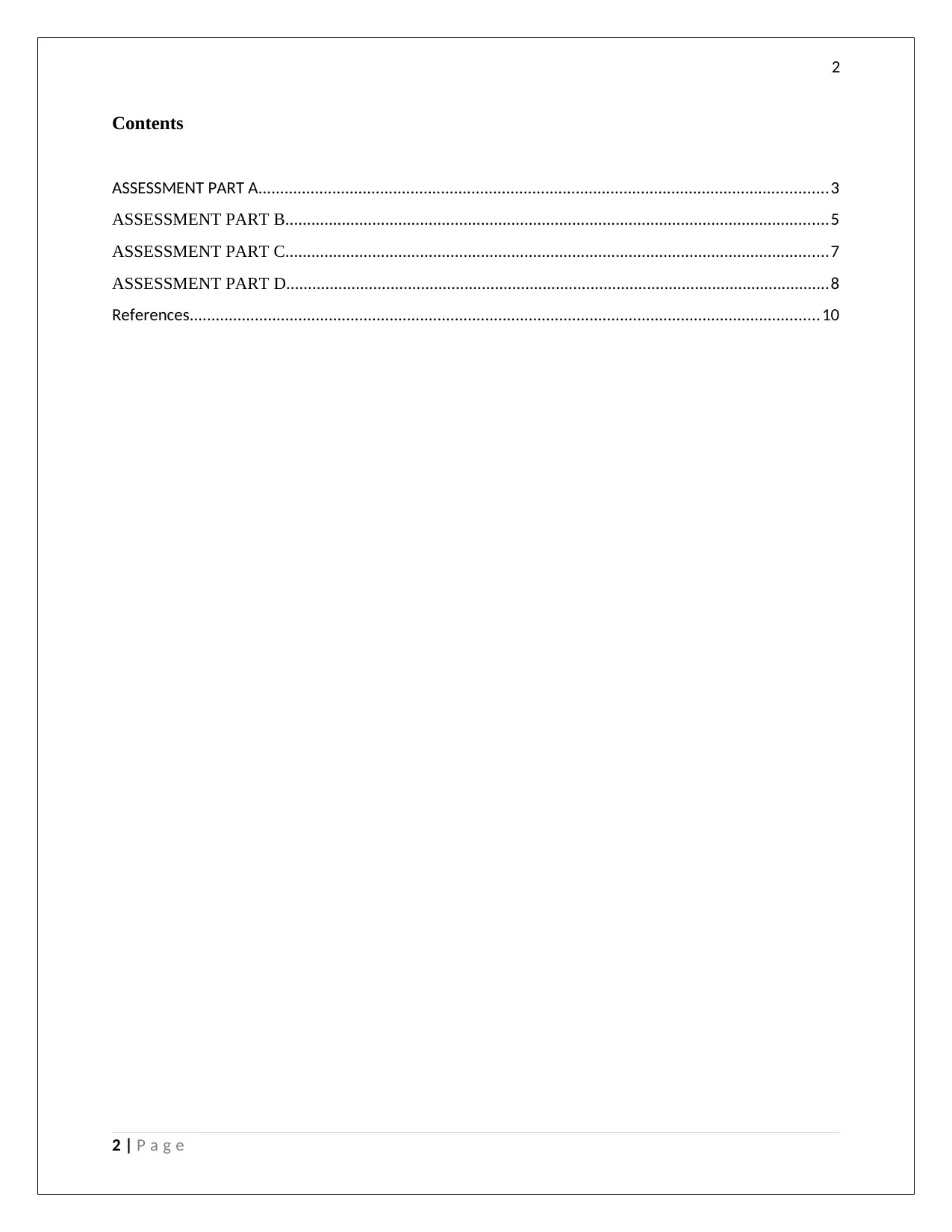
2
Contents
ASSESSMENT PART A...................................................................................................................................3
ASSESSMENT PART B.............................................................................................................................5
ASSESSMENT PART C.............................................................................................................................7
ASSESSMENT PART D.............................................................................................................................8
References.................................................................................................................................................10
2 | P a g e
Contents
ASSESSMENT PART A...................................................................................................................................3
ASSESSMENT PART B.............................................................................................................................5
ASSESSMENT PART C.............................................................................................................................7
ASSESSMENT PART D.............................................................................................................................8
References.................................................................................................................................................10
2 | P a g e
⊘ This is a preview!⊘
Do you want full access?
Subscribe today to unlock all pages.

Trusted by 1+ million students worldwide
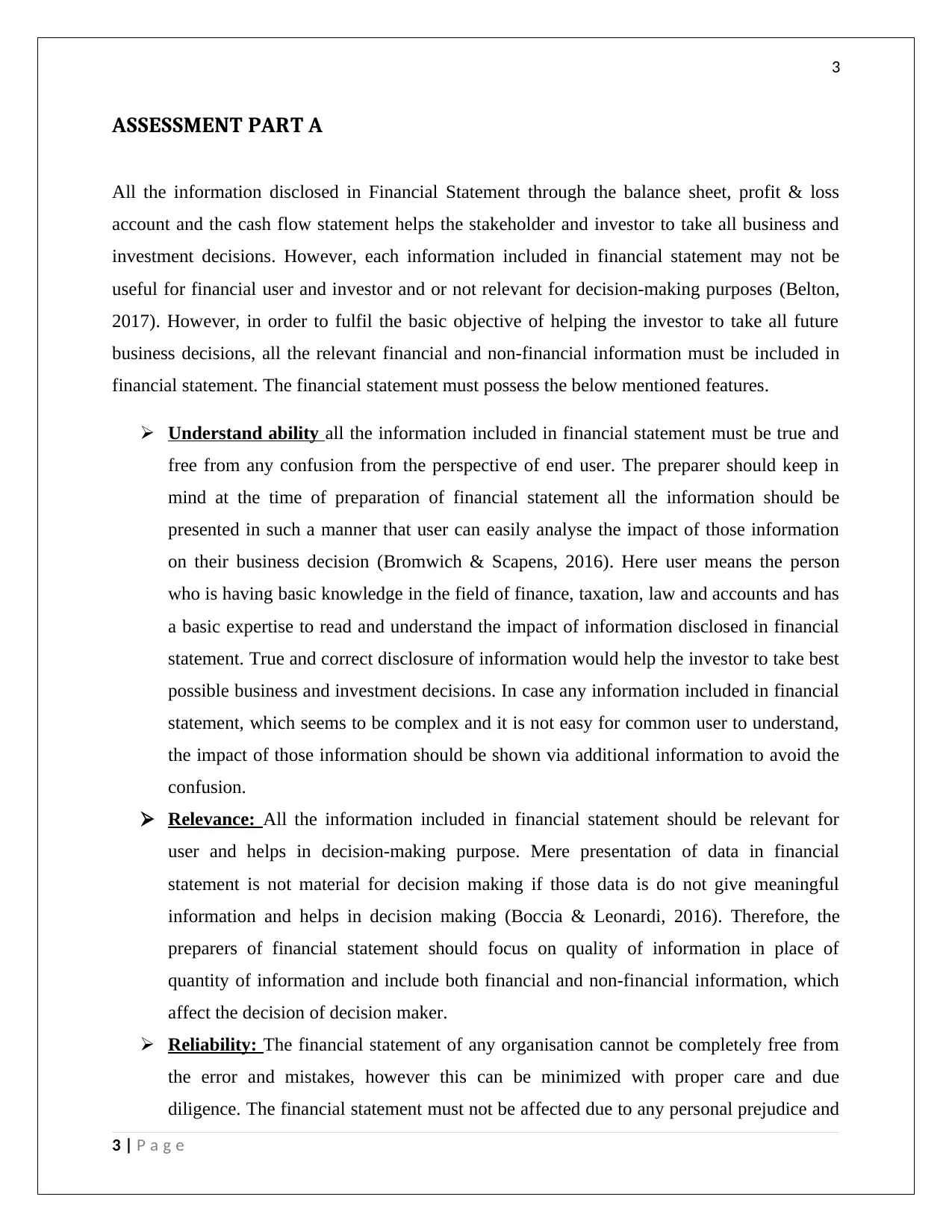
3
ASSESSMENT PART A
All the information disclosed in Financial Statement through the balance sheet, profit & loss
account and the cash flow statement helps the stakeholder and investor to take all business and
investment decisions. However, each information included in financial statement may not be
useful for financial user and investor and or not relevant for decision-making purposes (Belton,
2017). However, in order to fulfil the basic objective of helping the investor to take all future
business decisions, all the relevant financial and non-financial information must be included in
financial statement. The financial statement must possess the below mentioned features.
Understand ability all the information included in financial statement must be true and
free from any confusion from the perspective of end user. The preparer should keep in
mind at the time of preparation of financial statement all the information should be
presented in such a manner that user can easily analyse the impact of those information
on their business decision (Bromwich & Scapens, 2016). Here user means the person
who is having basic knowledge in the field of finance, taxation, law and accounts and has
a basic expertise to read and understand the impact of information disclosed in financial
statement. True and correct disclosure of information would help the investor to take best
possible business and investment decisions. In case any information included in financial
statement, which seems to be complex and it is not easy for common user to understand,
the impact of those information should be shown via additional information to avoid the
confusion.
Relevance: All the information included in financial statement should be relevant for
user and helps in decision-making purpose. Mere presentation of data in financial
statement is not material for decision making if those data is do not give meaningful
information and helps in decision making (Boccia & Leonardi, 2016). Therefore, the
preparers of financial statement should focus on quality of information in place of
quantity of information and include both financial and non-financial information, which
affect the decision of decision maker.
Reliability: The financial statement of any organisation cannot be completely free from
the error and mistakes, however this can be minimized with proper care and due
diligence. The financial statement must not be affected due to any personal prejudice and
3 | P a g e
ASSESSMENT PART A
All the information disclosed in Financial Statement through the balance sheet, profit & loss
account and the cash flow statement helps the stakeholder and investor to take all business and
investment decisions. However, each information included in financial statement may not be
useful for financial user and investor and or not relevant for decision-making purposes (Belton,
2017). However, in order to fulfil the basic objective of helping the investor to take all future
business decisions, all the relevant financial and non-financial information must be included in
financial statement. The financial statement must possess the below mentioned features.
Understand ability all the information included in financial statement must be true and
free from any confusion from the perspective of end user. The preparer should keep in
mind at the time of preparation of financial statement all the information should be
presented in such a manner that user can easily analyse the impact of those information
on their business decision (Bromwich & Scapens, 2016). Here user means the person
who is having basic knowledge in the field of finance, taxation, law and accounts and has
a basic expertise to read and understand the impact of information disclosed in financial
statement. True and correct disclosure of information would help the investor to take best
possible business and investment decisions. In case any information included in financial
statement, which seems to be complex and it is not easy for common user to understand,
the impact of those information should be shown via additional information to avoid the
confusion.
Relevance: All the information included in financial statement should be relevant for
user and helps in decision-making purpose. Mere presentation of data in financial
statement is not material for decision making if those data is do not give meaningful
information and helps in decision making (Boccia & Leonardi, 2016). Therefore, the
preparers of financial statement should focus on quality of information in place of
quantity of information and include both financial and non-financial information, which
affect the decision of decision maker.
Reliability: The financial statement of any organisation cannot be completely free from
the error and mistakes, however this can be minimized with proper care and due
diligence. The financial statement must not be affected due to any personal prejudice and
3 | P a g e
Paraphrase This Document
Need a fresh take? Get an instant paraphrase of this document with our AI Paraphraser
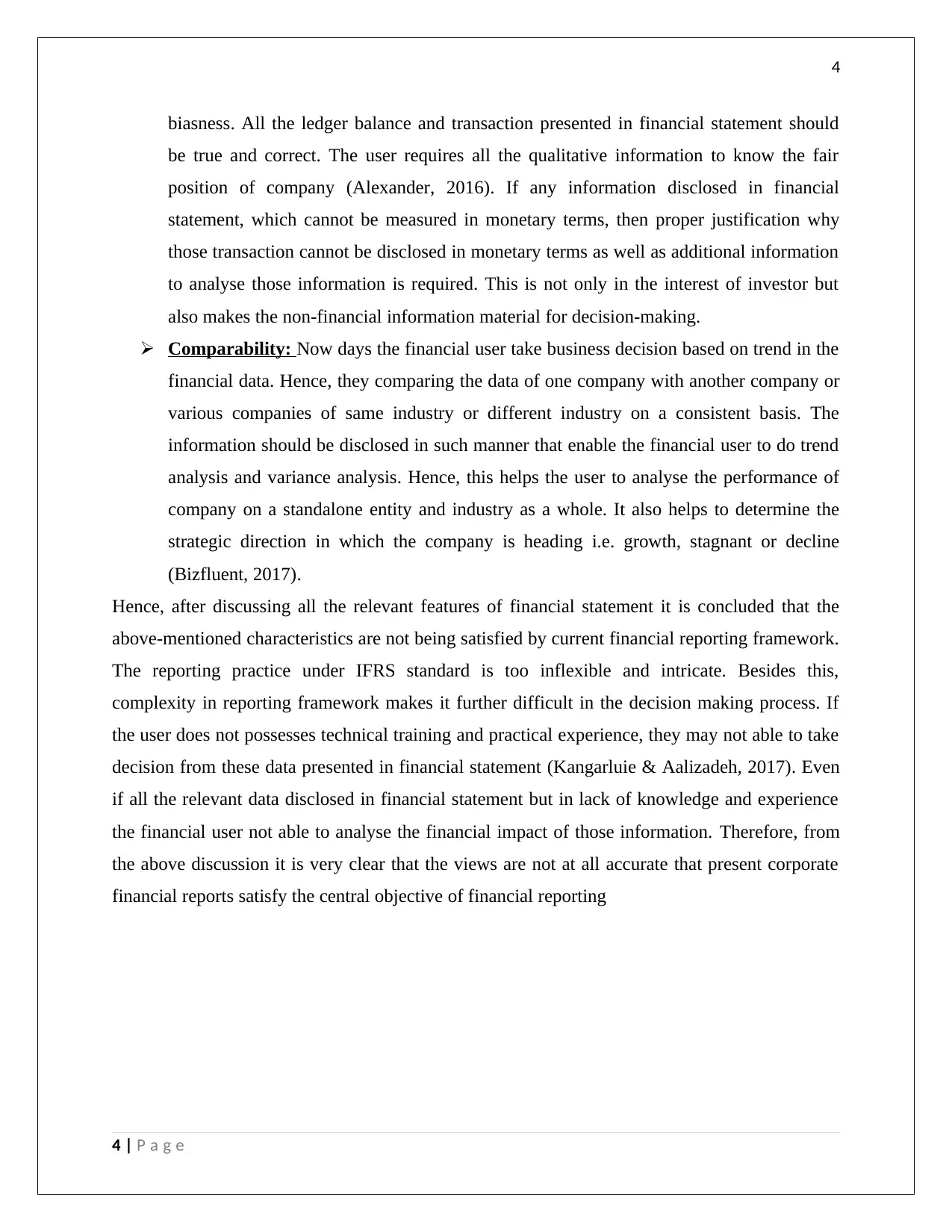
4
biasness. All the ledger balance and transaction presented in financial statement should
be true and correct. The user requires all the qualitative information to know the fair
position of company (Alexander, 2016). If any information disclosed in financial
statement, which cannot be measured in monetary terms, then proper justification why
those transaction cannot be disclosed in monetary terms as well as additional information
to analyse those information is required. This is not only in the interest of investor but
also makes the non-financial information material for decision-making.
Comparability: Now days the financial user take business decision based on trend in the
financial data. Hence, they comparing the data of one company with another company or
various companies of same industry or different industry on a consistent basis. The
information should be disclosed in such manner that enable the financial user to do trend
analysis and variance analysis. Hence, this helps the user to analyse the performance of
company on a standalone entity and industry as a whole. It also helps to determine the
strategic direction in which the company is heading i.e. growth, stagnant or decline
(Bizfluent, 2017).
Hence, after discussing all the relevant features of financial statement it is concluded that the
above-mentioned characteristics are not being satisfied by current financial reporting framework.
The reporting practice under IFRS standard is too inflexible and intricate. Besides this,
complexity in reporting framework makes it further difficult in the decision making process. If
the user does not possesses technical training and practical experience, they may not able to take
decision from these data presented in financial statement (Kangarluie & Aalizadeh, 2017). Even
if all the relevant data disclosed in financial statement but in lack of knowledge and experience
the financial user not able to analyse the financial impact of those information. Therefore, from
the above discussion it is very clear that the views are not at all accurate that present corporate
financial reports satisfy the central objective of financial reporting
4 | P a g e
biasness. All the ledger balance and transaction presented in financial statement should
be true and correct. The user requires all the qualitative information to know the fair
position of company (Alexander, 2016). If any information disclosed in financial
statement, which cannot be measured in monetary terms, then proper justification why
those transaction cannot be disclosed in monetary terms as well as additional information
to analyse those information is required. This is not only in the interest of investor but
also makes the non-financial information material for decision-making.
Comparability: Now days the financial user take business decision based on trend in the
financial data. Hence, they comparing the data of one company with another company or
various companies of same industry or different industry on a consistent basis. The
information should be disclosed in such manner that enable the financial user to do trend
analysis and variance analysis. Hence, this helps the user to analyse the performance of
company on a standalone entity and industry as a whole. It also helps to determine the
strategic direction in which the company is heading i.e. growth, stagnant or decline
(Bizfluent, 2017).
Hence, after discussing all the relevant features of financial statement it is concluded that the
above-mentioned characteristics are not being satisfied by current financial reporting framework.
The reporting practice under IFRS standard is too inflexible and intricate. Besides this,
complexity in reporting framework makes it further difficult in the decision making process. If
the user does not possesses technical training and practical experience, they may not able to take
decision from these data presented in financial statement (Kangarluie & Aalizadeh, 2017). Even
if all the relevant data disclosed in financial statement but in lack of knowledge and experience
the financial user not able to analyse the financial impact of those information. Therefore, from
the above discussion it is very clear that the views are not at all accurate that present corporate
financial reports satisfy the central objective of financial reporting
4 | P a g e
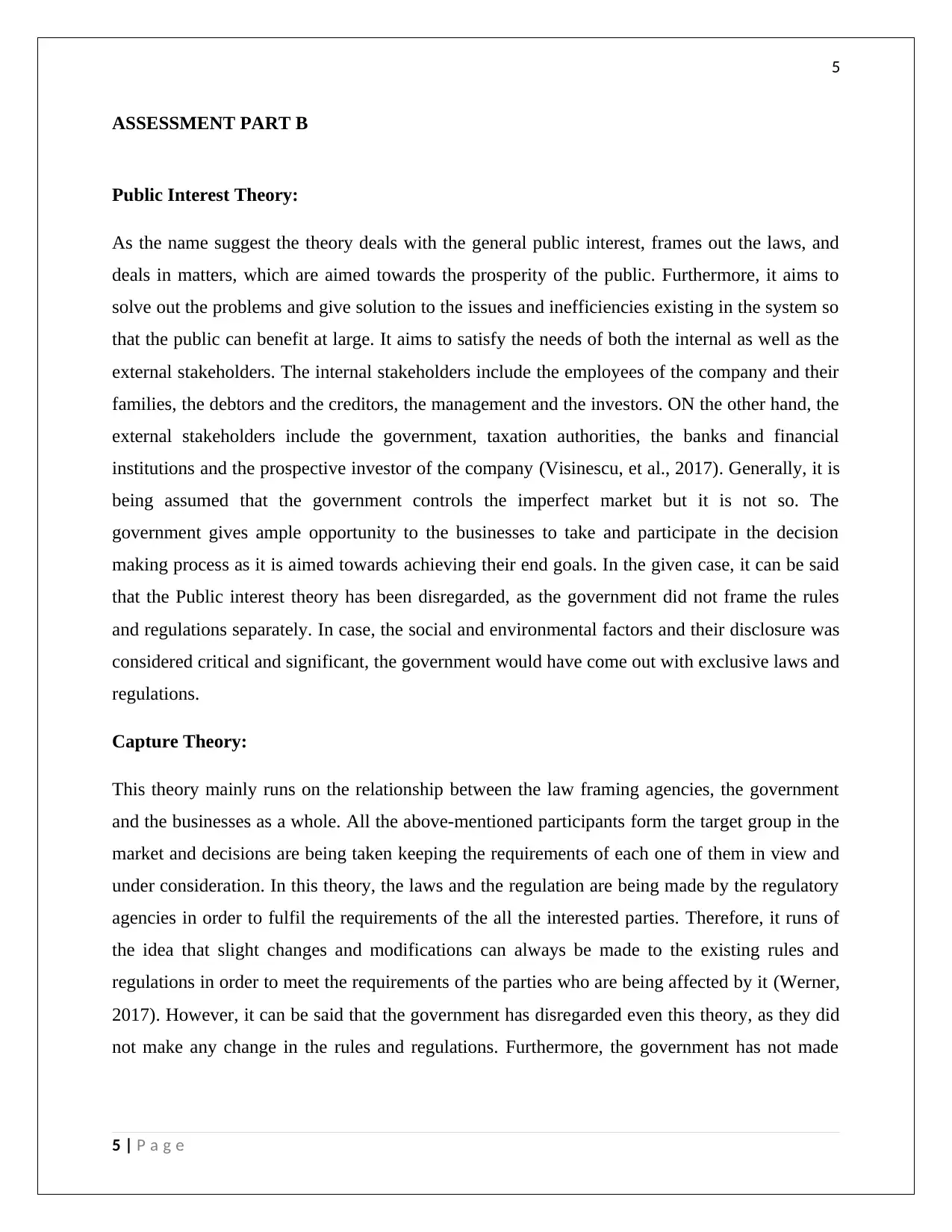
5
ASSESSMENT PART B
Public Interest Theory:
As the name suggest the theory deals with the general public interest, frames out the laws, and
deals in matters, which are aimed towards the prosperity of the public. Furthermore, it aims to
solve out the problems and give solution to the issues and inefficiencies existing in the system so
that the public can benefit at large. It aims to satisfy the needs of both the internal as well as the
external stakeholders. The internal stakeholders include the employees of the company and their
families, the debtors and the creditors, the management and the investors. ON the other hand, the
external stakeholders include the government, taxation authorities, the banks and financial
institutions and the prospective investor of the company (Visinescu, et al., 2017). Generally, it is
being assumed that the government controls the imperfect market but it is not so. The
government gives ample opportunity to the businesses to take and participate in the decision
making process as it is aimed towards achieving their end goals. In the given case, it can be said
that the Public interest theory has been disregarded, as the government did not frame the rules
and regulations separately. In case, the social and environmental factors and their disclosure was
considered critical and significant, the government would have come out with exclusive laws and
regulations.
Capture Theory:
This theory mainly runs on the relationship between the law framing agencies, the government
and the businesses as a whole. All the above-mentioned participants form the target group in the
market and decisions are being taken keeping the requirements of each one of them in view and
under consideration. In this theory, the laws and the regulation are being made by the regulatory
agencies in order to fulfil the requirements of the all the interested parties. Therefore, it runs of
the idea that slight changes and modifications can always be made to the existing rules and
regulations in order to meet the requirements of the parties who are being affected by it (Werner,
2017). However, it can be said that the government has disregarded even this theory, as they did
not make any change in the rules and regulations. Furthermore, the government has not made
5 | P a g e
ASSESSMENT PART B
Public Interest Theory:
As the name suggest the theory deals with the general public interest, frames out the laws, and
deals in matters, which are aimed towards the prosperity of the public. Furthermore, it aims to
solve out the problems and give solution to the issues and inefficiencies existing in the system so
that the public can benefit at large. It aims to satisfy the needs of both the internal as well as the
external stakeholders. The internal stakeholders include the employees of the company and their
families, the debtors and the creditors, the management and the investors. ON the other hand, the
external stakeholders include the government, taxation authorities, the banks and financial
institutions and the prospective investor of the company (Visinescu, et al., 2017). Generally, it is
being assumed that the government controls the imperfect market but it is not so. The
government gives ample opportunity to the businesses to take and participate in the decision
making process as it is aimed towards achieving their end goals. In the given case, it can be said
that the Public interest theory has been disregarded, as the government did not frame the rules
and regulations separately. In case, the social and environmental factors and their disclosure was
considered critical and significant, the government would have come out with exclusive laws and
regulations.
Capture Theory:
This theory mainly runs on the relationship between the law framing agencies, the government
and the businesses as a whole. All the above-mentioned participants form the target group in the
market and decisions are being taken keeping the requirements of each one of them in view and
under consideration. In this theory, the laws and the regulation are being made by the regulatory
agencies in order to fulfil the requirements of the all the interested parties. Therefore, it runs of
the idea that slight changes and modifications can always be made to the existing rules and
regulations in order to meet the requirements of the parties who are being affected by it (Werner,
2017). However, it can be said that the government has disregarded even this theory, as they did
not make any change in the rules and regulations. Furthermore, the government has not made
5 | P a g e
⊘ This is a preview!⊘
Do you want full access?
Subscribe today to unlock all pages.

Trusted by 1+ million students worldwide
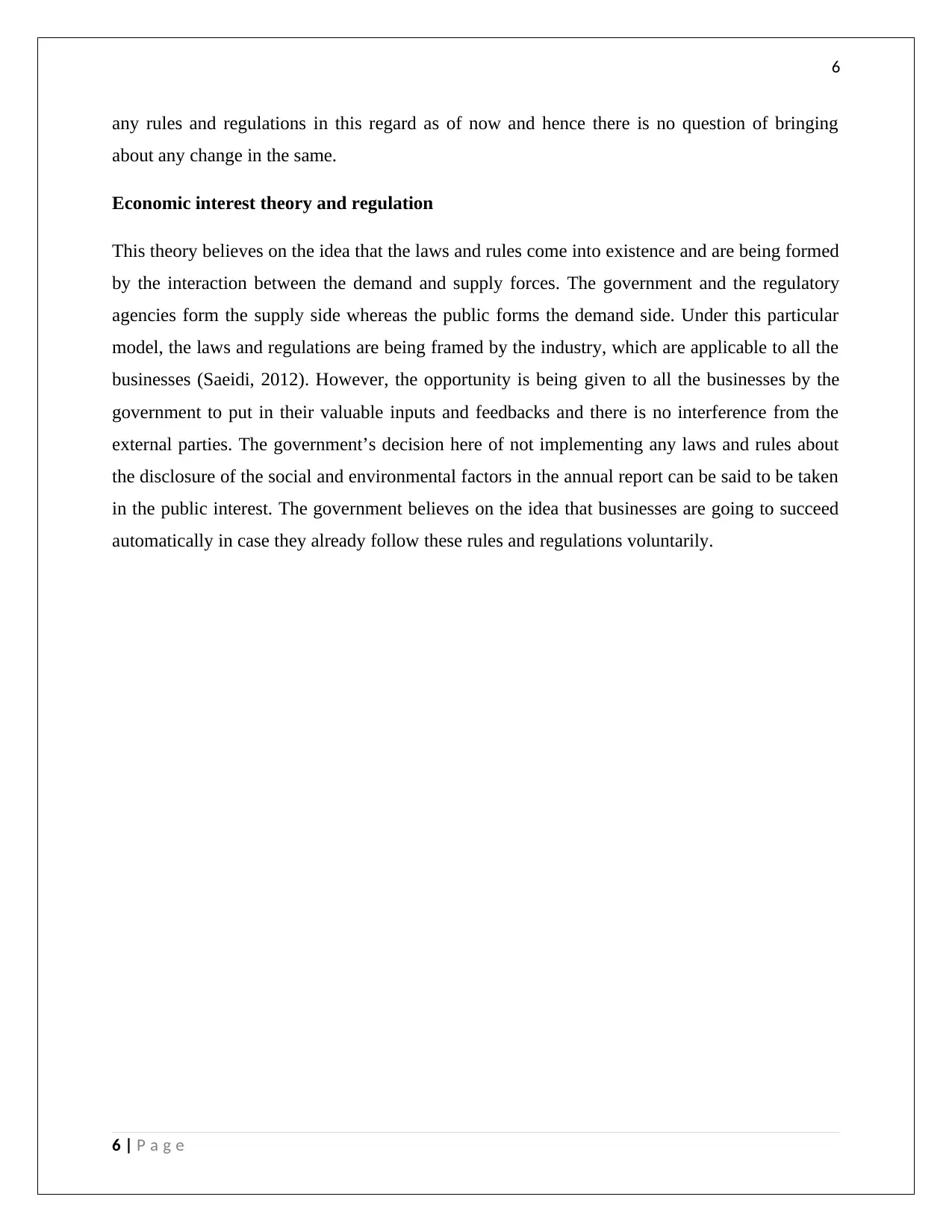
6
any rules and regulations in this regard as of now and hence there is no question of bringing
about any change in the same.
Economic interest theory and regulation
This theory believes on the idea that the laws and rules come into existence and are being formed
by the interaction between the demand and supply forces. The government and the regulatory
agencies form the supply side whereas the public forms the demand side. Under this particular
model, the laws and regulations are being framed by the industry, which are applicable to all the
businesses (Saeidi, 2012). However, the opportunity is being given to all the businesses by the
government to put in their valuable inputs and feedbacks and there is no interference from the
external parties. The government’s decision here of not implementing any laws and rules about
the disclosure of the social and environmental factors in the annual report can be said to be taken
in the public interest. The government believes on the idea that businesses are going to succeed
automatically in case they already follow these rules and regulations voluntarily.
6 | P a g e
any rules and regulations in this regard as of now and hence there is no question of bringing
about any change in the same.
Economic interest theory and regulation
This theory believes on the idea that the laws and rules come into existence and are being formed
by the interaction between the demand and supply forces. The government and the regulatory
agencies form the supply side whereas the public forms the demand side. Under this particular
model, the laws and regulations are being framed by the industry, which are applicable to all the
businesses (Saeidi, 2012). However, the opportunity is being given to all the businesses by the
government to put in their valuable inputs and feedbacks and there is no interference from the
external parties. The government’s decision here of not implementing any laws and rules about
the disclosure of the social and environmental factors in the annual report can be said to be taken
in the public interest. The government believes on the idea that businesses are going to succeed
automatically in case they already follow these rules and regulations voluntarily.
6 | P a g e
Paraphrase This Document
Need a fresh take? Get an instant paraphrase of this document with our AI Paraphraser
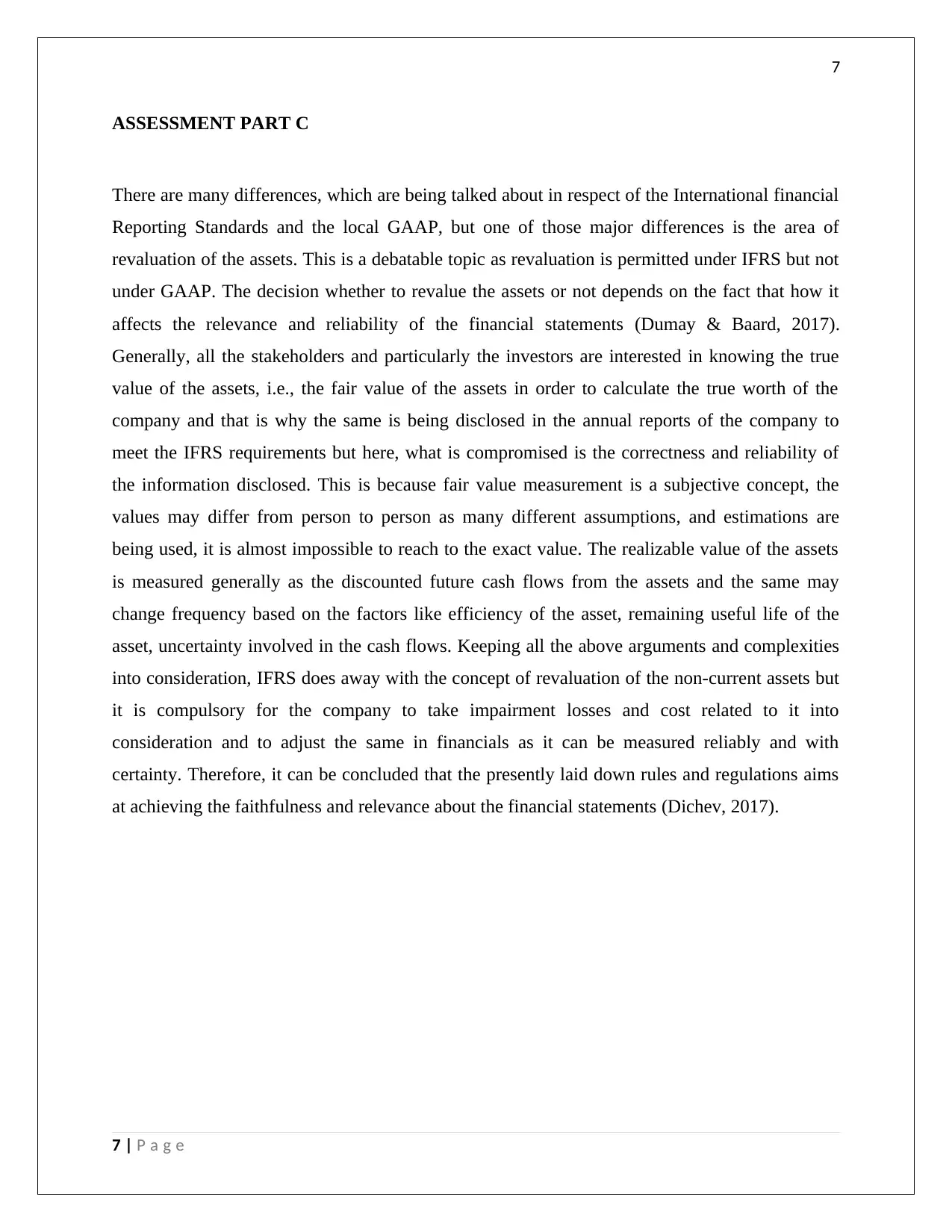
7
ASSESSMENT PART C
There are many differences, which are being talked about in respect of the International financial
Reporting Standards and the local GAAP, but one of those major differences is the area of
revaluation of the assets. This is a debatable topic as revaluation is permitted under IFRS but not
under GAAP. The decision whether to revalue the assets or not depends on the fact that how it
affects the relevance and reliability of the financial statements (Dumay & Baard, 2017).
Generally, all the stakeholders and particularly the investors are interested in knowing the true
value of the assets, i.e., the fair value of the assets in order to calculate the true worth of the
company and that is why the same is being disclosed in the annual reports of the company to
meet the IFRS requirements but here, what is compromised is the correctness and reliability of
the information disclosed. This is because fair value measurement is a subjective concept, the
values may differ from person to person as many different assumptions, and estimations are
being used, it is almost impossible to reach to the exact value. The realizable value of the assets
is measured generally as the discounted future cash flows from the assets and the same may
change frequency based on the factors like efficiency of the asset, remaining useful life of the
asset, uncertainty involved in the cash flows. Keeping all the above arguments and complexities
into consideration, IFRS does away with the concept of revaluation of the non-current assets but
it is compulsory for the company to take impairment losses and cost related to it into
consideration and to adjust the same in financials as it can be measured reliably and with
certainty. Therefore, it can be concluded that the presently laid down rules and regulations aims
at achieving the faithfulness and relevance about the financial statements (Dichev, 2017).
7 | P a g e
ASSESSMENT PART C
There are many differences, which are being talked about in respect of the International financial
Reporting Standards and the local GAAP, but one of those major differences is the area of
revaluation of the assets. This is a debatable topic as revaluation is permitted under IFRS but not
under GAAP. The decision whether to revalue the assets or not depends on the fact that how it
affects the relevance and reliability of the financial statements (Dumay & Baard, 2017).
Generally, all the stakeholders and particularly the investors are interested in knowing the true
value of the assets, i.e., the fair value of the assets in order to calculate the true worth of the
company and that is why the same is being disclosed in the annual reports of the company to
meet the IFRS requirements but here, what is compromised is the correctness and reliability of
the information disclosed. This is because fair value measurement is a subjective concept, the
values may differ from person to person as many different assumptions, and estimations are
being used, it is almost impossible to reach to the exact value. The realizable value of the assets
is measured generally as the discounted future cash flows from the assets and the same may
change frequency based on the factors like efficiency of the asset, remaining useful life of the
asset, uncertainty involved in the cash flows. Keeping all the above arguments and complexities
into consideration, IFRS does away with the concept of revaluation of the non-current assets but
it is compulsory for the company to take impairment losses and cost related to it into
consideration and to adjust the same in financials as it can be measured reliably and with
certainty. Therefore, it can be concluded that the presently laid down rules and regulations aims
at achieving the faithfulness and relevance about the financial statements (Dichev, 2017).
7 | P a g e
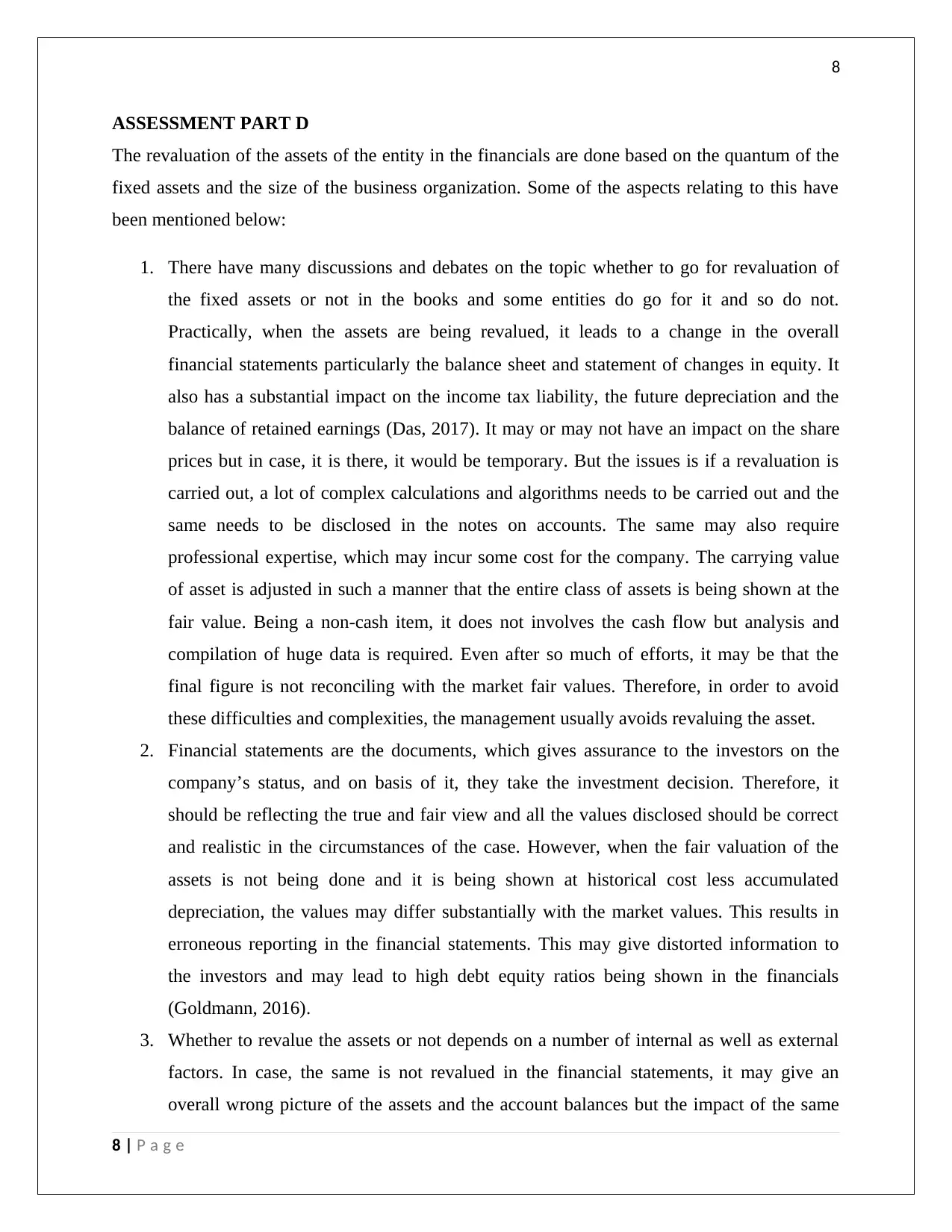
8
ASSESSMENT PART D
The revaluation of the assets of the entity in the financials are done based on the quantum of the
fixed assets and the size of the business organization. Some of the aspects relating to this have
been mentioned below:
1. There have many discussions and debates on the topic whether to go for revaluation of
the fixed assets or not in the books and some entities do go for it and so do not.
Practically, when the assets are being revalued, it leads to a change in the overall
financial statements particularly the balance sheet and statement of changes in equity. It
also has a substantial impact on the income tax liability, the future depreciation and the
balance of retained earnings (Das, 2017). It may or may not have an impact on the share
prices but in case, it is there, it would be temporary. But the issues is if a revaluation is
carried out, a lot of complex calculations and algorithms needs to be carried out and the
same needs to be disclosed in the notes on accounts. The same may also require
professional expertise, which may incur some cost for the company. The carrying value
of asset is adjusted in such a manner that the entire class of assets is being shown at the
fair value. Being a non-cash item, it does not involves the cash flow but analysis and
compilation of huge data is required. Even after so much of efforts, it may be that the
final figure is not reconciling with the market fair values. Therefore, in order to avoid
these difficulties and complexities, the management usually avoids revaluing the asset.
2. Financial statements are the documents, which gives assurance to the investors on the
company’s status, and on basis of it, they take the investment decision. Therefore, it
should be reflecting the true and fair view and all the values disclosed should be correct
and realistic in the circumstances of the case. However, when the fair valuation of the
assets is not being done and it is being shown at historical cost less accumulated
depreciation, the values may differ substantially with the market values. This results in
erroneous reporting in the financial statements. This may give distorted information to
the investors and may lead to high debt equity ratios being shown in the financials
(Goldmann, 2016).
3. Whether to revalue the assets or not depends on a number of internal as well as external
factors. In case, the same is not revalued in the financial statements, it may give an
overall wrong picture of the assets and the account balances but the impact of the same
8 | P a g e
ASSESSMENT PART D
The revaluation of the assets of the entity in the financials are done based on the quantum of the
fixed assets and the size of the business organization. Some of the aspects relating to this have
been mentioned below:
1. There have many discussions and debates on the topic whether to go for revaluation of
the fixed assets or not in the books and some entities do go for it and so do not.
Practically, when the assets are being revalued, it leads to a change in the overall
financial statements particularly the balance sheet and statement of changes in equity. It
also has a substantial impact on the income tax liability, the future depreciation and the
balance of retained earnings (Das, 2017). It may or may not have an impact on the share
prices but in case, it is there, it would be temporary. But the issues is if a revaluation is
carried out, a lot of complex calculations and algorithms needs to be carried out and the
same needs to be disclosed in the notes on accounts. The same may also require
professional expertise, which may incur some cost for the company. The carrying value
of asset is adjusted in such a manner that the entire class of assets is being shown at the
fair value. Being a non-cash item, it does not involves the cash flow but analysis and
compilation of huge data is required. Even after so much of efforts, it may be that the
final figure is not reconciling with the market fair values. Therefore, in order to avoid
these difficulties and complexities, the management usually avoids revaluing the asset.
2. Financial statements are the documents, which gives assurance to the investors on the
company’s status, and on basis of it, they take the investment decision. Therefore, it
should be reflecting the true and fair view and all the values disclosed should be correct
and realistic in the circumstances of the case. However, when the fair valuation of the
assets is not being done and it is being shown at historical cost less accumulated
depreciation, the values may differ substantially with the market values. This results in
erroneous reporting in the financial statements. This may give distorted information to
the investors and may lead to high debt equity ratios being shown in the financials
(Goldmann, 2016).
3. Whether to revalue the assets or not depends on a number of internal as well as external
factors. In case, the same is not revalued in the financial statements, it may give an
overall wrong picture of the assets and the account balances but the impact of the same
8 | P a g e
⊘ This is a preview!⊘
Do you want full access?
Subscribe today to unlock all pages.

Trusted by 1+ million students worldwide
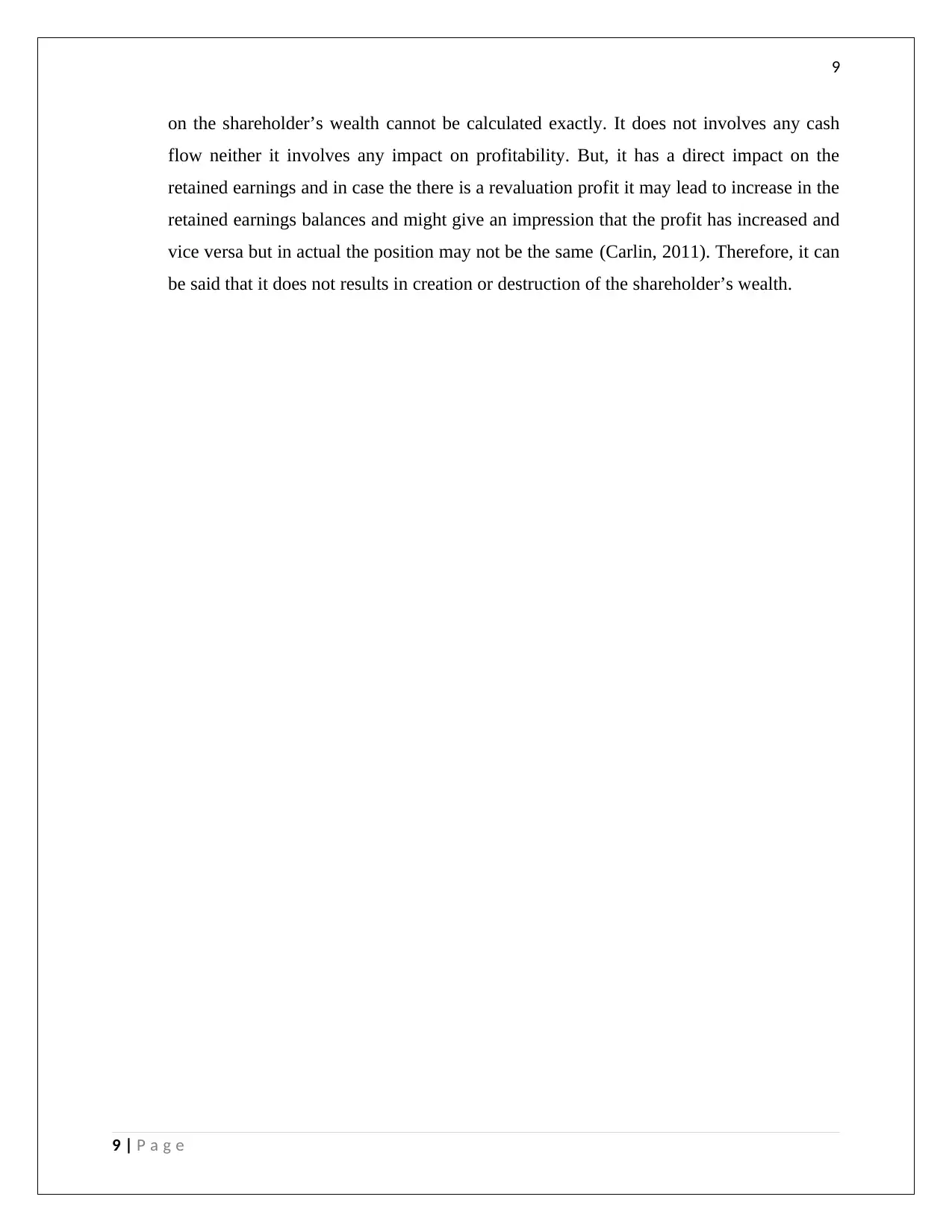
9
on the shareholder’s wealth cannot be calculated exactly. It does not involves any cash
flow neither it involves any impact on profitability. But, it has a direct impact on the
retained earnings and in case the there is a revaluation profit it may lead to increase in the
retained earnings balances and might give an impression that the profit has increased and
vice versa but in actual the position may not be the same (Carlin, 2011). Therefore, it can
be said that it does not results in creation or destruction of the shareholder’s wealth.
9 | P a g e
on the shareholder’s wealth cannot be calculated exactly. It does not involves any cash
flow neither it involves any impact on profitability. But, it has a direct impact on the
retained earnings and in case the there is a revaluation profit it may lead to increase in the
retained earnings balances and might give an impression that the profit has increased and
vice versa but in actual the position may not be the same (Carlin, 2011). Therefore, it can
be said that it does not results in creation or destruction of the shareholder’s wealth.
9 | P a g e
Paraphrase This Document
Need a fresh take? Get an instant paraphrase of this document with our AI Paraphraser
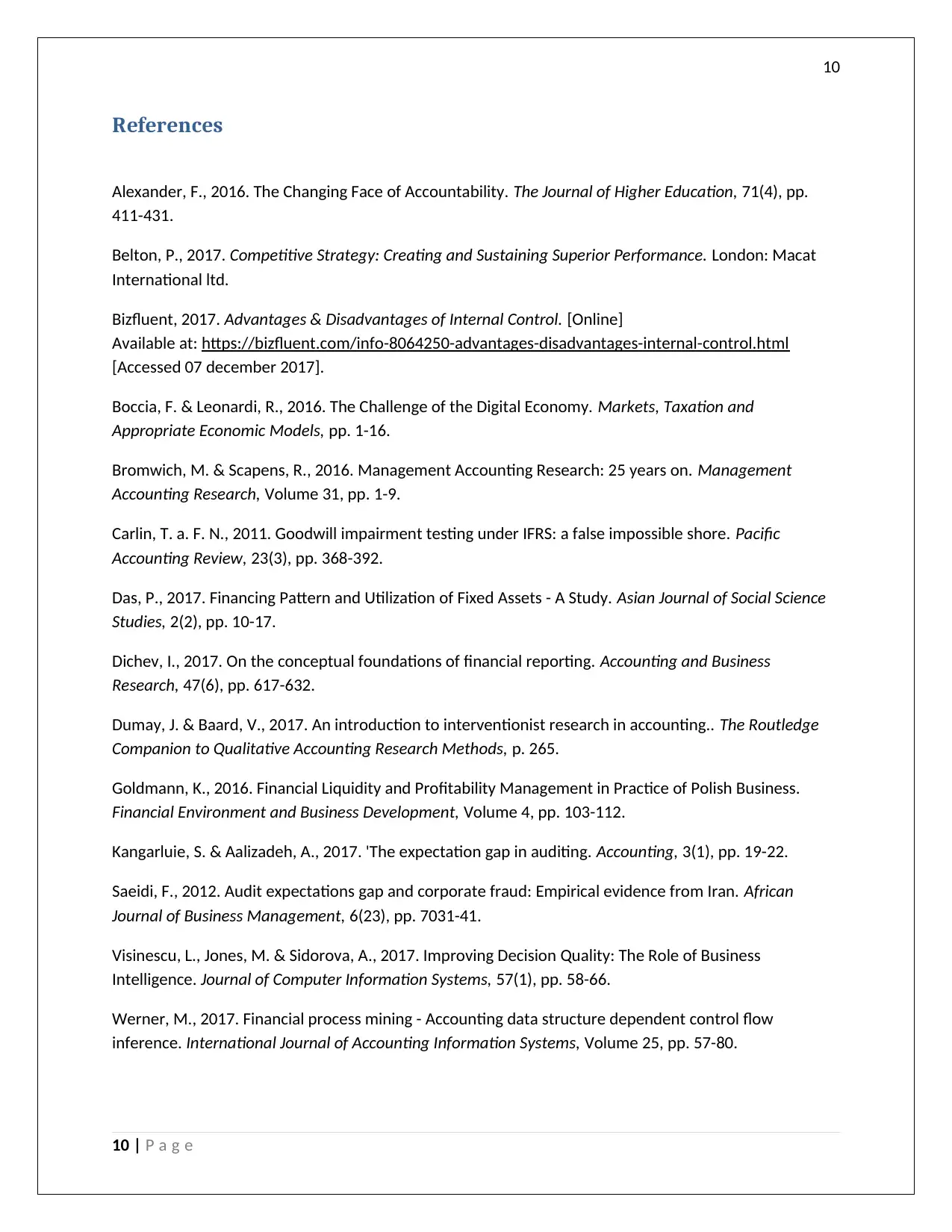
10
References
Alexander, F., 2016. The Changing Face of Accountability. The Journal of Higher Education, 71(4), pp.
411-431.
Belton, P., 2017. Competitive Strategy: Creating and Sustaining Superior Performance. London: Macat
International ltd.
Bizfluent, 2017. Advantages & Disadvantages of Internal Control. [Online]
Available at: https://bizfluent.com/info-8064250-advantages-disadvantages-internal-control.html
[Accessed 07 december 2017].
Boccia, F. & Leonardi, R., 2016. The Challenge of the Digital Economy. Markets, Taxation and
Appropriate Economic Models, pp. 1-16.
Bromwich, M. & Scapens, R., 2016. Management Accounting Research: 25 years on. Management
Accounting Research, Volume 31, pp. 1-9.
Carlin, T. a. F. N., 2011. Goodwill impairment testing under IFRS: a false impossible shore. Pacific
Accounting Review, 23(3), pp. 368-392.
Das, P., 2017. Financing Pattern and Utilization of Fixed Assets - A Study. Asian Journal of Social Science
Studies, 2(2), pp. 10-17.
Dichev, I., 2017. On the conceptual foundations of financial reporting. Accounting and Business
Research, 47(6), pp. 617-632.
Dumay, J. & Baard, V., 2017. An introduction to interventionist research in accounting.. The Routledge
Companion to Qualitative Accounting Research Methods, p. 265.
Goldmann, K., 2016. Financial Liquidity and Profitability Management in Practice of Polish Business.
Financial Environment and Business Development, Volume 4, pp. 103-112.
Kangarluie, S. & Aalizadeh, A., 2017. 'The expectation gap in auditing. Accounting, 3(1), pp. 19-22.
Saeidi, F., 2012. Audit expectations gap and corporate fraud: Empirical evidence from Iran. African
Journal of Business Management, 6(23), pp. 7031-41.
Visinescu, L., Jones, M. & Sidorova, A., 2017. Improving Decision Quality: The Role of Business
Intelligence. Journal of Computer Information Systems, 57(1), pp. 58-66.
Werner, M., 2017. Financial process mining - Accounting data structure dependent control flow
inference. International Journal of Accounting Information Systems, Volume 25, pp. 57-80.
10 | P a g e
References
Alexander, F., 2016. The Changing Face of Accountability. The Journal of Higher Education, 71(4), pp.
411-431.
Belton, P., 2017. Competitive Strategy: Creating and Sustaining Superior Performance. London: Macat
International ltd.
Bizfluent, 2017. Advantages & Disadvantages of Internal Control. [Online]
Available at: https://bizfluent.com/info-8064250-advantages-disadvantages-internal-control.html
[Accessed 07 december 2017].
Boccia, F. & Leonardi, R., 2016. The Challenge of the Digital Economy. Markets, Taxation and
Appropriate Economic Models, pp. 1-16.
Bromwich, M. & Scapens, R., 2016. Management Accounting Research: 25 years on. Management
Accounting Research, Volume 31, pp. 1-9.
Carlin, T. a. F. N., 2011. Goodwill impairment testing under IFRS: a false impossible shore. Pacific
Accounting Review, 23(3), pp. 368-392.
Das, P., 2017. Financing Pattern and Utilization of Fixed Assets - A Study. Asian Journal of Social Science
Studies, 2(2), pp. 10-17.
Dichev, I., 2017. On the conceptual foundations of financial reporting. Accounting and Business
Research, 47(6), pp. 617-632.
Dumay, J. & Baard, V., 2017. An introduction to interventionist research in accounting.. The Routledge
Companion to Qualitative Accounting Research Methods, p. 265.
Goldmann, K., 2016. Financial Liquidity and Profitability Management in Practice of Polish Business.
Financial Environment and Business Development, Volume 4, pp. 103-112.
Kangarluie, S. & Aalizadeh, A., 2017. 'The expectation gap in auditing. Accounting, 3(1), pp. 19-22.
Saeidi, F., 2012. Audit expectations gap and corporate fraud: Empirical evidence from Iran. African
Journal of Business Management, 6(23), pp. 7031-41.
Visinescu, L., Jones, M. & Sidorova, A., 2017. Improving Decision Quality: The Role of Business
Intelligence. Journal of Computer Information Systems, 57(1), pp. 58-66.
Werner, M., 2017. Financial process mining - Accounting data structure dependent control flow
inference. International Journal of Accounting Information Systems, Volume 25, pp. 57-80.
10 | P a g e

11
11 | P a g e
11 | P a g e
⊘ This is a preview!⊘
Do you want full access?
Subscribe today to unlock all pages.

Trusted by 1+ million students worldwide
1 out of 12
Related Documents
Your All-in-One AI-Powered Toolkit for Academic Success.
+13062052269
info@desklib.com
Available 24*7 on WhatsApp / Email
![[object Object]](/_next/static/media/star-bottom.7253800d.svg)
Unlock your academic potential
Copyright © 2020–2025 A2Z Services. All Rights Reserved. Developed and managed by ZUCOL.





